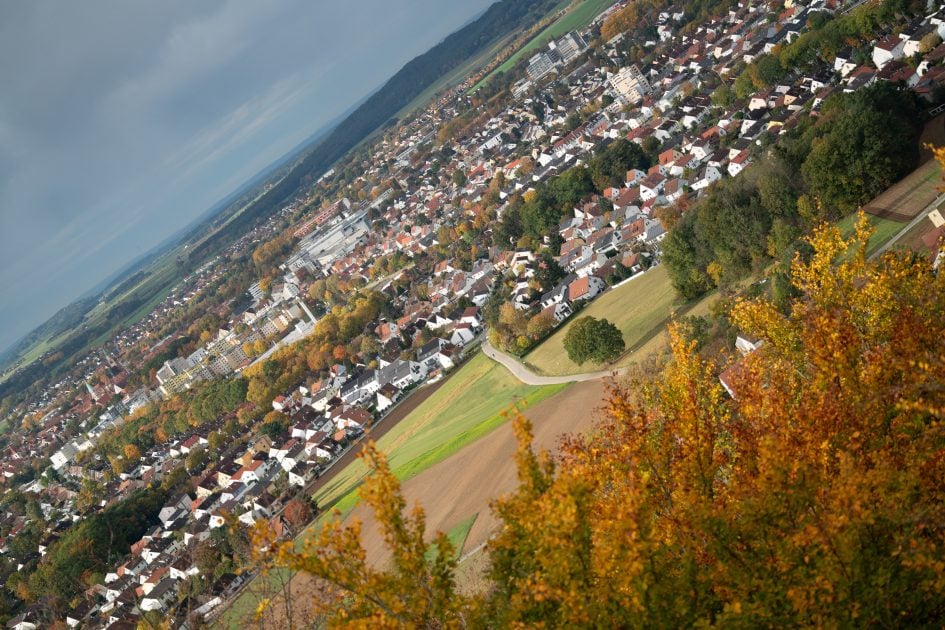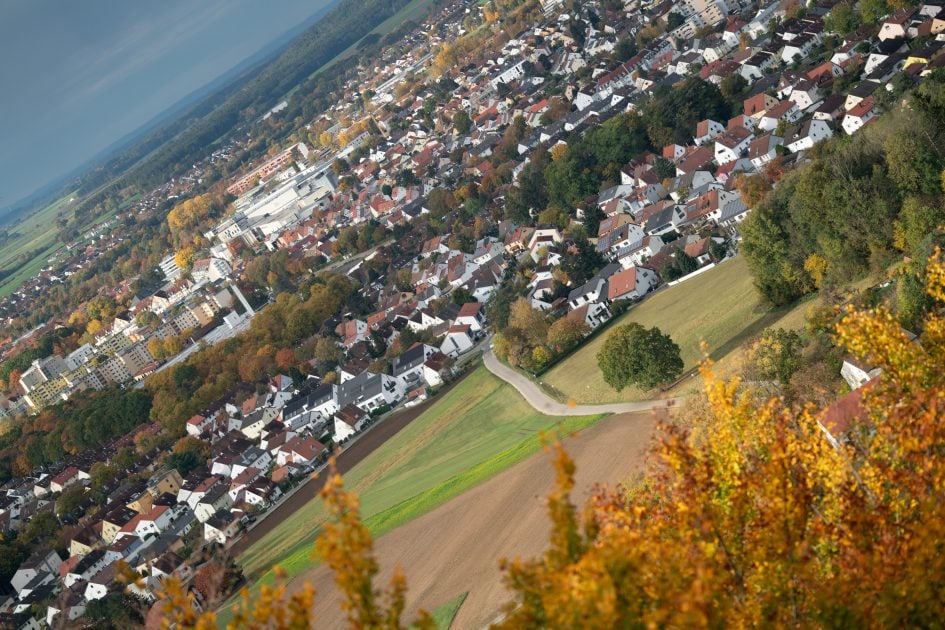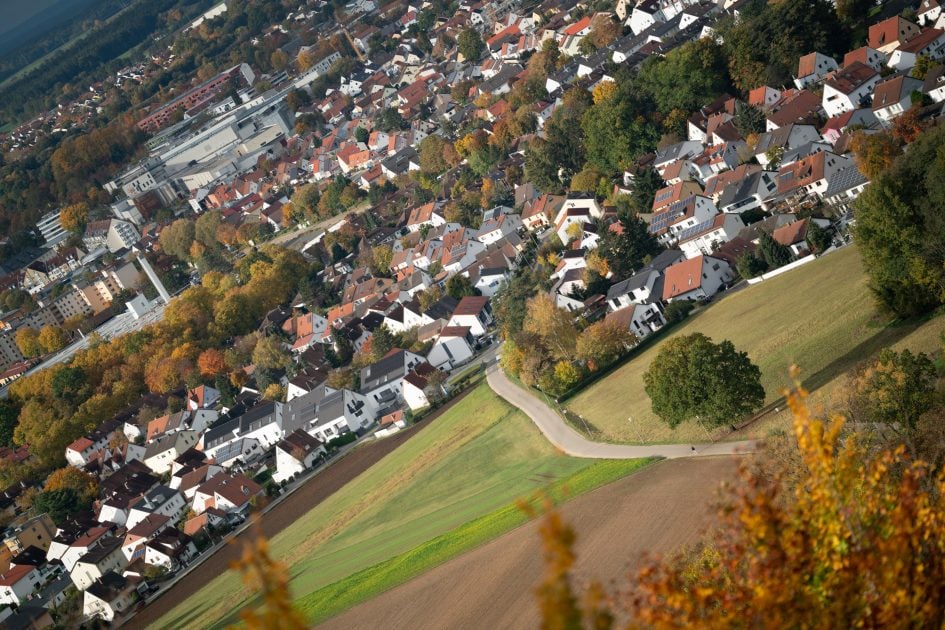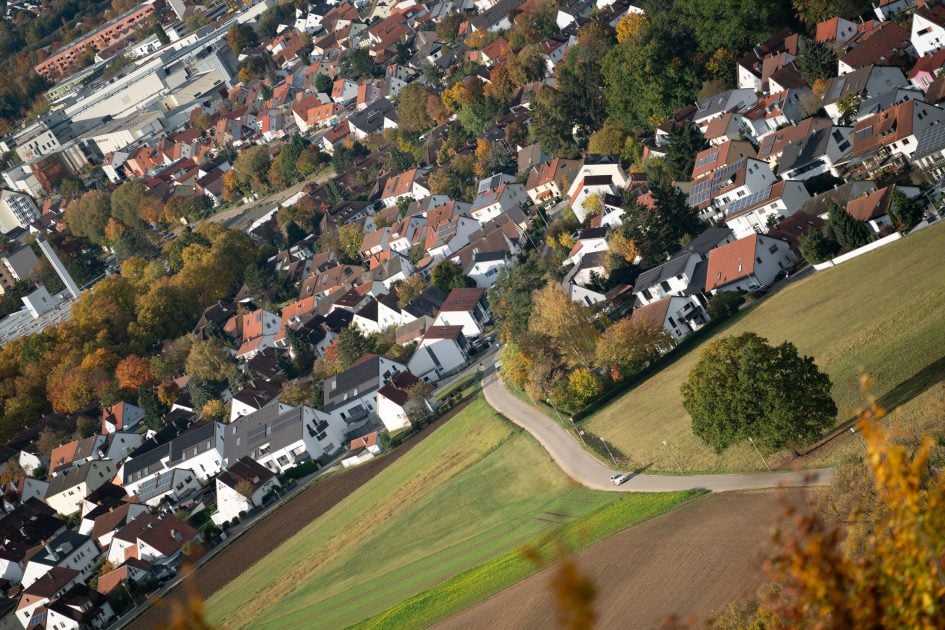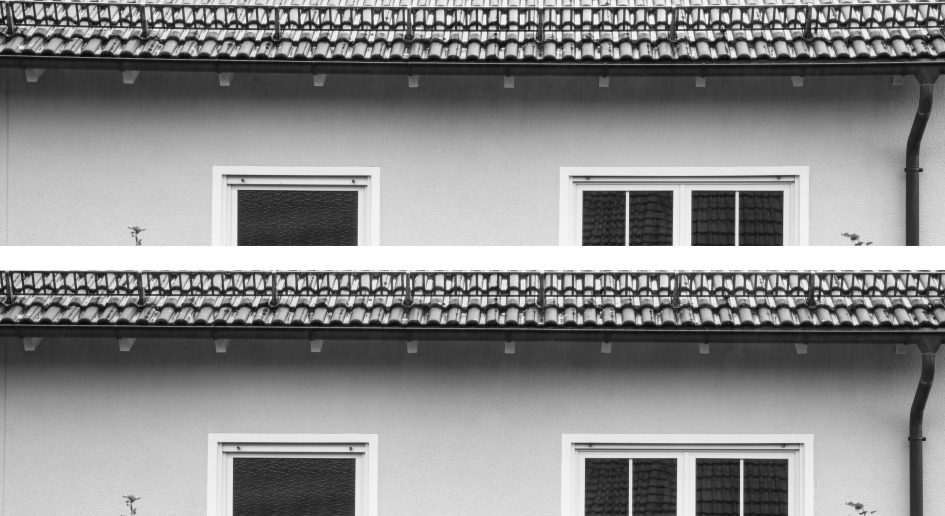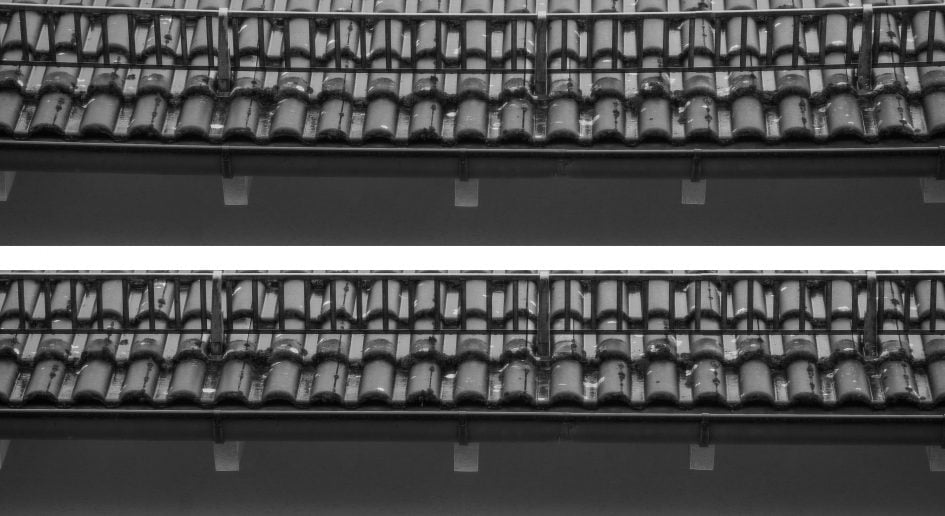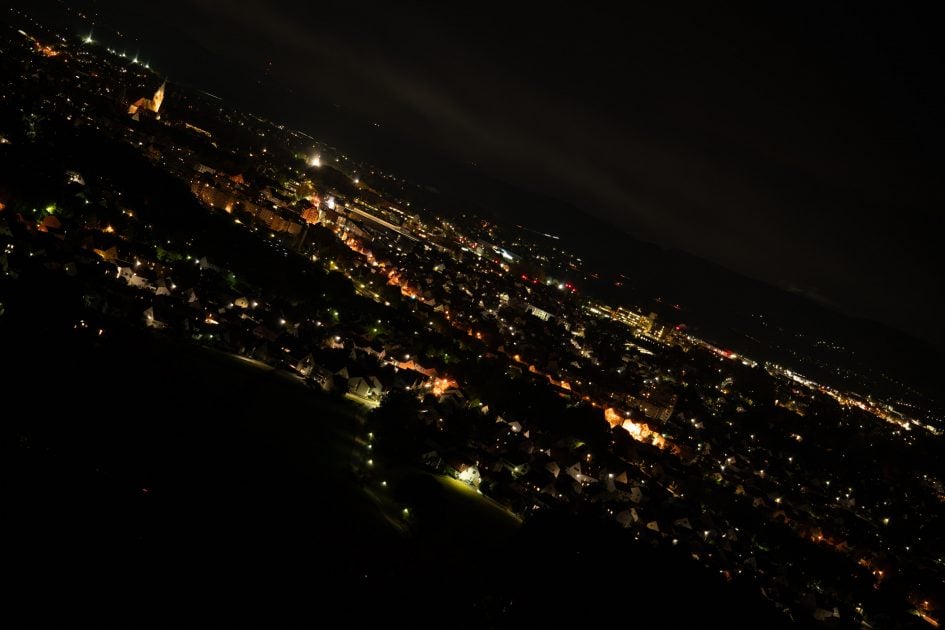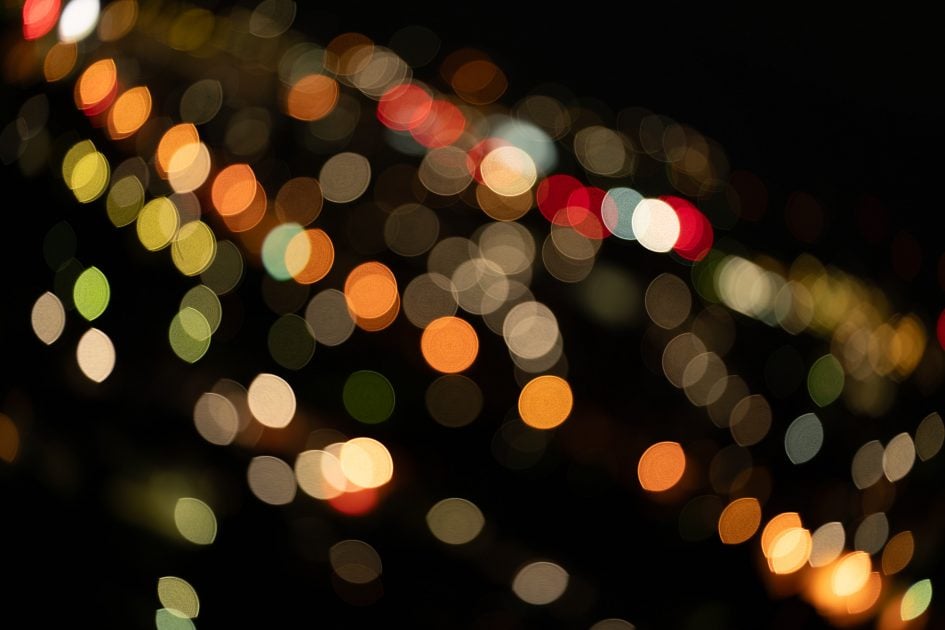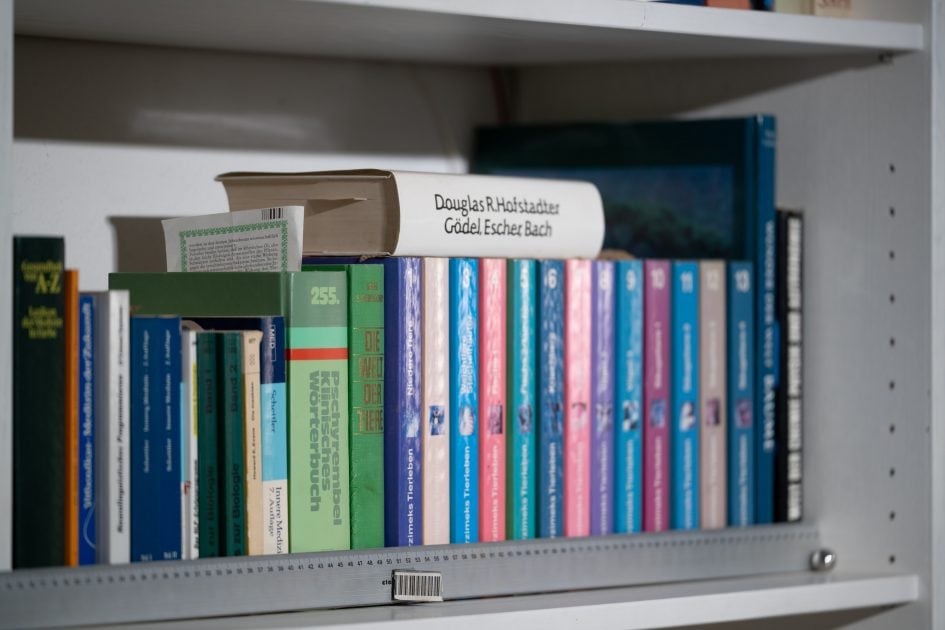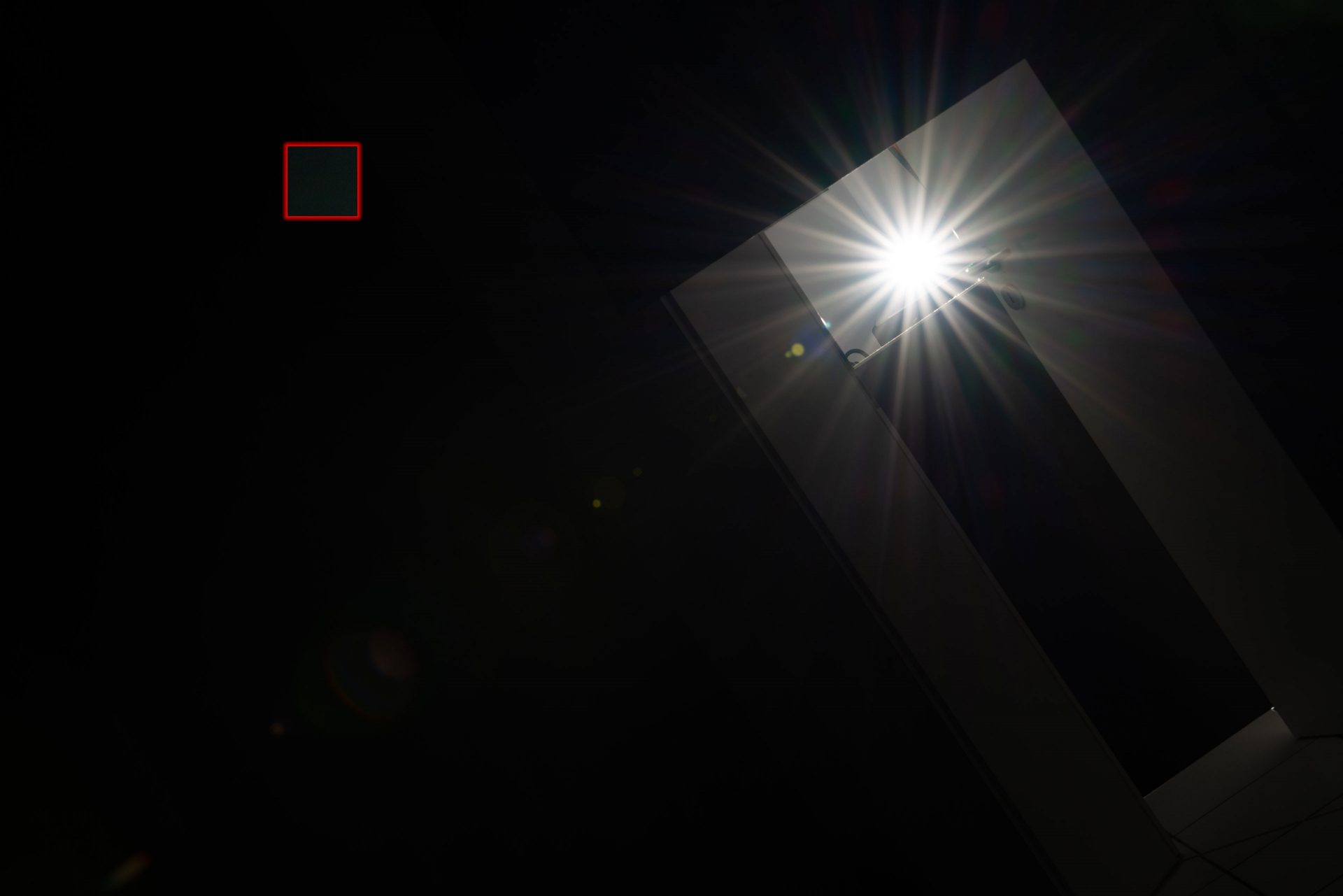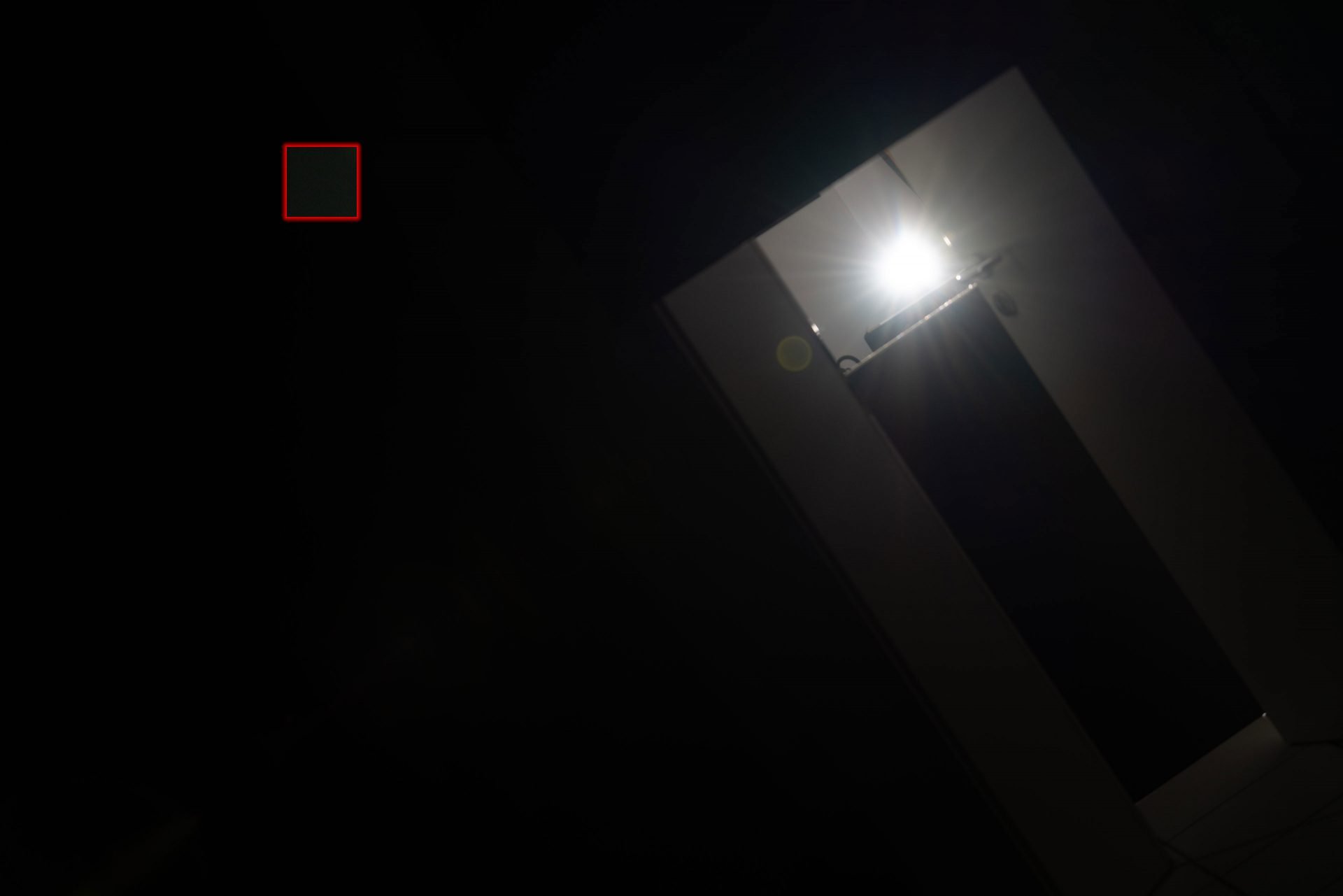Tamron 70-180mm f2.8 Di III VC G2 review
-
-
Written by Thomas
Quality
Longitudinal Chromatic Aberration and focus shift
Lenses with focal ratios of f2.8 or larger are often prone to longitudinal color aberrations (loCA, a.k.a. “axial color” or “bokeh CA”). These normally show up as magenta coloration in the foreground and greenish hues in the background and are not easily corrected in post-processing. The Tamron G2 has very little loCA even on specular highlights.
Tamron 70-180mm f2.8 VC G2 Longitudinal Chromatic Aberration (loCA) at 180mm
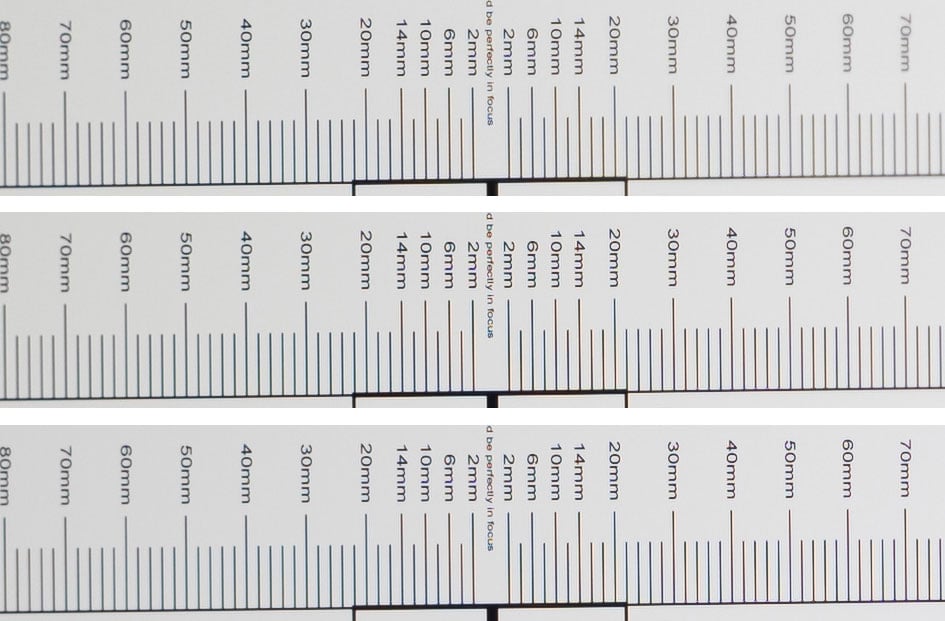
100% crops, from top to bottom: f2.8, f4.0, f5.6; left = foreground, right = background
The test also shows that the background becomes sharper faster than the foreground and there’s a small amount of focus shift.
The following real life shot shows that the Tamron 70-180mm f2.8 VC G2 produces no purple fringing around high-contrast edges in the focal plane and only minimal green outlining around background subjects:
Above: Tamron 70-180mm f2.8 VC G2 at 70mm f2.8, 100% crop, +2/3EV exp. comp.; click image for 4k version, here for large original
There’s also much less glare and bleeding of bright background light into the figures than with the Tamron G1 (shot another day but both crops exposed identically):
Above: Tamron 70-180mm f2.8 G1 at 70mm f2.8, 100% crop; click image for 4k version, here for large original
Sharpness and contrast
Let’s have a look at the theoretical performance of the Tamron 70-180mm f2.8 VC G2 first and compare it to the Tamron 70-180mm f2.8 G1 and Sony 70-200mm f2.8 GM OSS II:
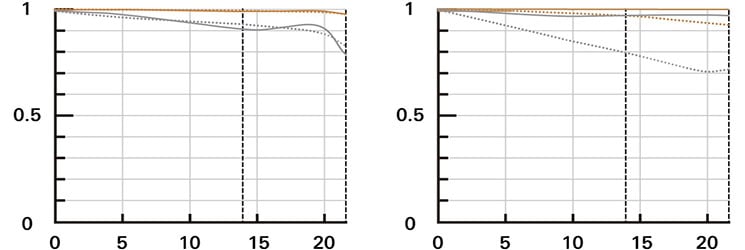
Above: MTF Tamron 70-180mm f2.8 VC G2 at 70mm f2.8 (left), 180mm f2.8 (right)
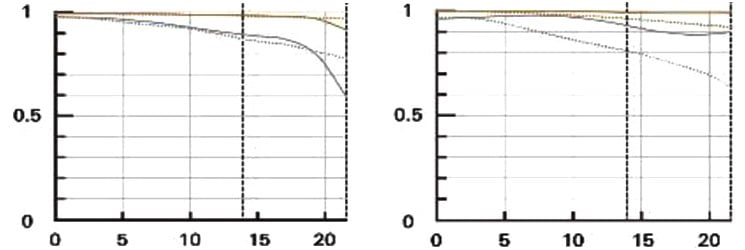
Above: MTF Tamron 70-180mm f2.8 G1 at 70mm f2.8 (left), 180mm f2.8 (right)
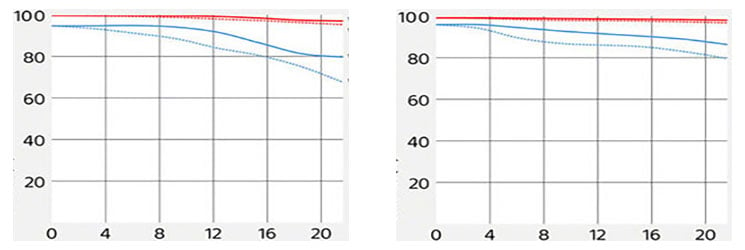
Above: MTF Sony 70-200mm f2.8 GM OSS II at 70mm f2.8 (left), 200mm f2.8 (right)
These MTF charts show the computed lens-performance wide open without influence of diffraction at 10 line-pairs/mm (in yellow/red) and 30 lp/mm (in gray/blue). Higher values are better (more contrast) and the closer the dotted and solid lines are together the less astigmatism (= resolution depends on the orientation of the test-pattern) the lens has. The x-axis displays the “image height” which is the distance from the optical axis (=center of the sensor) in mm. I’ll show you the real-life performance at 4 mm (“center”), 13 mm (DX-corner), and 20 mm (FX-corner) on a 42MP Sony A7R II camera.
From the charts the Tamron 70-180mm f2.8 VC G2 should show better resolution than its predecessor at 70mm especially towards the full-frame corner. On the long end corner sharpness of the Tamron G2 should also be improved but there is still strong astigmatism which the Sony 70-200mm f2.8 GM OSS II seems to have better under control. On the wide end the Sony could be a bit less sharp outside the APS-C image circle than the Tamron G2. All-in-all this looks very promising for Tamron’s 70-180mm f2.8 VC G2.
Let’s see how this theoretical performance translates into real life results in the sharpness test based on Siemens-stars. Processing was done in Lightroom 13.0.1/CRAW 16.0 from RAW to Adobe Color profile with the lens profile for shading and CA compensation applied. Noise-reduction is set to 0, sharpening to 50/0.5/36/10, with no extra tone, color, or saturation adjustment. White-balance was adjusted to a neutral white and I did some exposure compensation to make the brightness of all crops match. So you will not see light fall-off in the corners.
The following are all 100% crops!
First up is an overview of the wide-open performance at different focal lengths. You can jump to the detailed results at different apertures and comparisons with the competition by clicking on the crops of the respective focal length.
Tamron 70-180mm f2.8 VC G2; 100% crop from near center, APS-C-corner, FF-corner
Above: 70mm, f2.8
Above: 100mm, f2.8
Above:140mm, f2.8
Above: 180mm, f2.8
Tamron’s new zoom lens is very sharp across the full-frame sensor throughout the zoom-range with just a slight softening in the FF-corner at 180mm focal length. At the shooting distances of this test (45x focal length) the lens also exhibits practically no field curvature at any focal length: I could take all crops in a row from the same shot with no need to re-focus.
If you want to see all the details and comparisons with the Tamron 70-180mm f2.8 Di III, read on. Or you can fast-forward to the performance at long distances.
The following 100% crops for each focal length show the Tamron 70-180mm f2.8 VC G2 from f2.8 down to f11 compared to the Tamron 70-200mm f2.8 G1 at f2.8.
Performance at 70mm:
Tamron 70-180mm f2.8 VC G2 at 70mm compared; 100% crop from near center, APS-C-corner, FF-corner

Above: Tamron 70-180mm f2.8 VC G2 at 70mm, f2.8

Above: Tamron 70-180mm f2.8 G1 at 70mm, f2.8; also available at f4.0, f5.6, f8.0, f11

Above: Tamron 70-180mm f2.8 VC G2 at 70mm, f4.0

Above: Tamron 70-180mm f2.8 VC G2 at 70mm, f5.6; also available at f8.0, f11
Compared to its predecessor the Tamron G2 looks a bit sharper in the center and FF-corner but a tad softer in the APS-C-corner.
Performance at 100mm:
Tamron 70-180mm f2.8 VC G2 at 100mm compared; 100% crop from near center, APS-C-corner, FF-corner

Above: Tamron 70-180mm f2.8 f2.8 VC G2 at 100mm, f2.8

Above: Tamron 70-180mm f2.8 G1 at 105mm, f2.8; also available at f4.0, f5.6, f8.0, f11

Above: Tamron 70-180mm f2.8 VC G2 at 100mm, f4.0

Above: Tamron 70-180mm f2.8 VC G2 at 100mm, f5.6; also available at f8.0, f11
At 100mm focal length differences between the Tamron G2 and G1 seem minimal.
Performance at 140mm:
Tamron 70-180mm f2.8 VC G2 at 140mm compared; 100% crop from near center, APS-C-corner, FF-corner

Above: Tamron 70-180mm f2.8 VC G2 at 140mm, f2.8

Above: Tamron 70-180mm f2.8 G1 at 150mm, f2.8; also available at f4.0, f5.6, f8.0, f11

Above: Tamron 70-180mm f2.8 VC G2 at 140mm, f4.0

Above: Tamron 70-180mm f2.8 VC G2 at 140mm, f5.6; also available at f8.0, f11
At 140mm focal length the Tamron G1 looks a bit sharper in the APS-C image-circle than the G2 but a tad less sharp in the FF-corner.
Performance at 180mm:
Tamron 70-180mm f2.8 VC G2 at 180mm compared; 100% crop from near center, APS-C-corner, FF-corner

Above: Tamron 70-180mm f2.8 VC G2 at 180mm, f2.8

Above: Tamron 70-180mm f2.8 G1 at 180mm, f2.8; also available at f4.0, f5.6, f8.0, f11

Above: Tamron 70-180mm f2.8 VC G2 at 180mm, f4.0

Above: Tamron 70-180mm f2.8 VC G2 at 180mm, f5.6; also available at f8.0, f11
At 180mm focal length both Tamrons look very similar in the APS-C image-circle but the Tamron G2 renders a sharper FF-corner – albeit with a bit more astigmatism than its predecessor.
Summary:
Overall Tamron’s 70-180mm f2.8 VC G2 zoom lens performs very similar to its predecessor – which is a good thing: The older lens already was very sharp.
Performance at long distances
The Siemens-star test-targets are shot at a distance of 45x focal length (i.e. at around 3m for 70mm focal length, 8m at 180mm). But performance of lenses also depends on the shooting distance. Therefore, I shot another series of images of a city around 1 km away. Processing was done in Lightroom 13.0.1/CRAW 16. from RAW to Adobe Color profile with the lens profile compensating CA and vignetting. Noise-reduction is set to 0, sharpening to 50/0.5/36/10, with no extra tone, color, or saturation adjustment. I used manual focus at the largest aperture and did not change focus for other apertures. All shots were made from a heavy tripod with image stabilization switched off at ISO 100 or ISO 200 to keep shutter speeds high enough to avoid any micro blur from gusts of wind. As usual I have selected the diagonal that provided the better corner results although the lens was only mildly decentered.
The following images show the complete scene wide open plus 100% crops from near the center, APS-C-corner, and FF-corner. You can access the large originals but please respect our copyright and only use those images for personal use.
Tamron 70-180mm f2.8 VC G2 at 70mm
Above: Tamron 70-180mm f2.8 VC G2 at 70mm, f2.8; click image for 4k version, here for large original; crops also available at f4.0, f5.6, f8.0
Tamron 70-180mm f2.8 VC G2 at 100mm
Above: Tamron 70-180mm f2.8 VC G2 at 100mm, f2.8; click image for 4k version, here for large original; crops also available at f4.0, f5.6, f8.0
Tamron 70-180mm f2.8 VC G2 at 140mm
Above: Tamron 70-180mm f2.8 VC G2 at 140mm, f2.8; click image for 4k version, here for large original; crops also available at f4.0, f5.6, f8.0
Tamron 70-180mm f2.8 VC G2 at 180mm
Above: Tamron 70-180mm f2.8 VC G2 at 180mm, f2.8; click image for 4k version, here for large original; crops also available at f4.0, f5.6, f8.0
Summary:
In this long-distance test the Tamron 70-180mm f2.8 VC G2 performed best across the full-frame sensor at the short end. The FF-corner becomes a bit softer at 100mm and the APS-C-corner also loses some of its acuity. At 140mm the center softens a bit (easily remedied by stopping down to f4.0) and the APS-C-corner comes back to very good sharpness. At 180mm the center is very sharp again but the corners soften a bit. Overall the lens is sharp to very sharp across the zoom-range and image-circle already at f2.8. Stopping down to f4.0 should seldom be necessary. Compared to its predecessor, the new optical formula of the Tamron G2 seems to result in a slight improvement.
Vignetting and distortions
To make it easier to see light fall-off in the corners of a full-frame sensor I’ve arranged a series of three shots each with the Tamron 70-180mm f2.8 VC G2 at 70mm and 180mm focal length and different apertures. All images were developed from RAW to the same brightness in the center and are shown with shading compensation in camera set to Off (1st row) or Auto (2nd row):
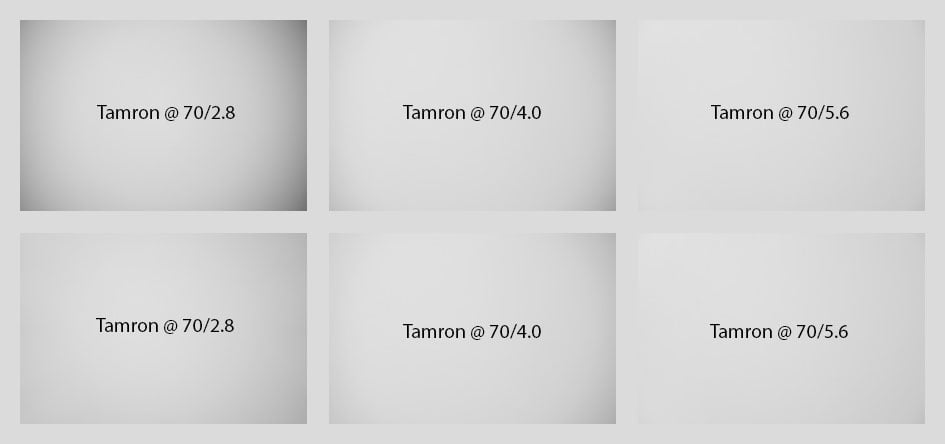
Above: Tamron 70-180mm f2.8 VC G2 at 70mm, as is (top) / with lens-profile (bottom)
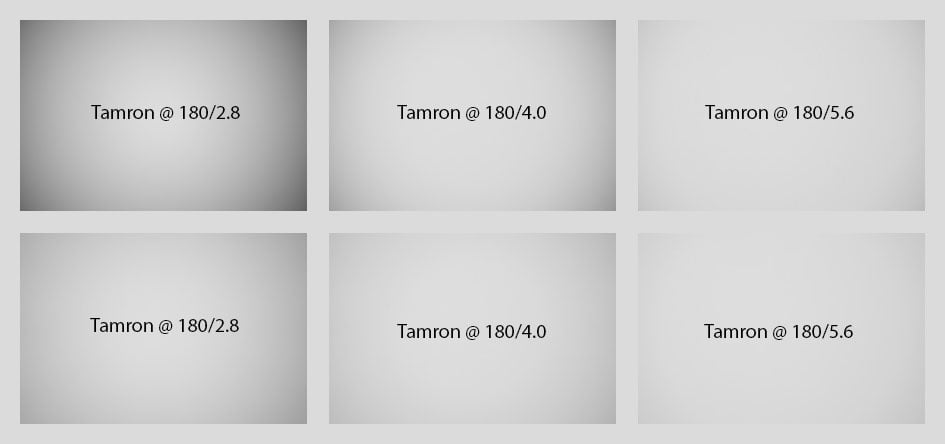
Above: Tamron 70-180mm f2.8 VC G2 at 180mm, as is (top) / with lens-profile (bottom)
At 70mm vignetting is quite strong wide open. Correction with the lens profile at f2.8 lifts the FX-corner by 0.9 EV. Btw.: The corners are darker on the right side not because of the lens but because I didn’t illuminate the target uniformly enough. At 180mm focal length light fall-off is a very strong. The lens profile now lifts the FX-corner by 1 EV at f2.8 which still leaves some falloff uncorrected. Adobe’s RAW converter automatically applies shading compensation as it was set in camera – but you cannot alter the setting in postprocessing
Distortions are a very noticeably pin-cushion at every focal length (see below). The lens profile corrects them well in camera. See the following composite images showing the upper part of two images shot as JPG:
Distortions: Tamron 70-180mm f2.8 VC G2 at 70mm, as is (top) / with lens-profile (bottom)
Distortions: Tamron 70-180mm f2.8 VC G2 at 180mm, as is (top) / with lens-profile (bottom)
At the time of writing the setting for distortion compensation in camera is ignored by Lightroom 13.0.1 / CRAW 16.0 and treated as OFF. Currently there’s also no lens profile for the Tamron G2 from Adobe so you have to manually correct with -5 at 70mm and -9 at 180mm which produces results very similar to what the lens profile does for JPGs in camera.
Rendering of point-light sources at night-shots
Night-shots pose a different challenge for lenses as the contrast is even higher than under bright sun and point-light sources can reveal some weaknesses such as coma, haloing and colour-aberrations that do not show up as prominently in other test-shots. The 100% crops below the main image show that coma in the FF-corner of the Tamron 70-180mm f2.8 VC G2 at 70mm focal length is practically non-existent:
Above: Tamron 70-180mm f2.8 VC G2 at 70mm, f2.8; click image for 4k version, here for large original

Above: Tamron 70-180mm f2.8 VC G2 at 70mm; 100% crops from the FF-corner at f2.8 (left), f4.0 (middle), f5.6 (right)
Bokeh quality
This test is for the rendering of point-light sources in an out-of-focus background. The circle of confusion that is produced by this test is pretty indicative of Bokeh performance (in the background) and light fall-off. Ideally the out-of-focus image of the point-light is evenly lit and perfectly circular, with no “onion-rings”, and without coloration. Large aperture lenses normally produce an effect known as “cat’s eye” the further away from the optical axis the point-light is projected. This is due to optical vignetting in the lens barrel when light enters the lens from an angle.
All images were shot at the longest focal length and largest aperture and manually corrected for distortions. The Tamron G2 is first followed by the Tamron G1 (shot another day). Crops are from near the center, APS-C-corner, and FF-corner resized to make them comparable across all my reviews.
Above: Tamron 70-180mm f2.8 VC G2 at 180mm, f2.8; click image for 4k version
Above: Tamron 70-180mm f2.8 VC G2 at 180mm, f2.8; click image for 100% crops
Above: Tamron 70-180mm f2.8 G1 at 180mm, f2.8; click image for 100% crop, here for 4k version
Above: Tamron 70-180mm f2.8 VC G2 at 180mm, f4.0; click image for 100% crops
Above: Tamron 70-180mm f2.8 VC G2 at 180mm, f5.6; click image for 100% crops
Above: Tamron 70-180mm f2.8 VC G2 at 180mm, f8.0; click image for 100% crops
Both Tamron lenses show only very mild onion rings with some additional grainy texture in the Bokeh balls. Outlining is negligible on the Tamron G1 but the new lens shows some. Coloration from loCA is not an issue. But looking towards the corners both lenses develop pretty strong cat’s eyes – the Tamron 70-180mm f2.8 VC G2 even slightly stronger in the FF-corner than its predecessor.
Let’s see how this analysis of out-of-focus point-light sources translates into Bokeh-performance shooting a book-shelf. Crops are from the foreground, middle-ground, and background resized to make them comparable across all my reviews. I used the longest focal length that I could to produce a comparable shot to my other reviews which was in the case of the Tamron G2 171mm while the Tamron G1 had to be zoomed in to 165mm:
Above: Tamron 70-180mm f2.8 VC G2 at 171mm, f2.8; click image for 4k version, here for large original
Above: Tamron 70-180mm f2.8 VC G2 at 171mm, f2.8; click image for 4k version, here for large original
Above: Tamron 70-180mm f2.8 G1 at 165mm, f2.8; click image for 4k version, here for large original
Looking at the crops it is immediately clear that the Tamron G2 has the more desirable Bokeh than its predecessor: It is much softer in the transition zone and also less harsh in the background. In the foreground both lenses look more alike with the Tamron G2 producing the slightly bigger blur. Looking at the ruler (now at 100%) confirms again that the Tamron G2 produces the softer transition zone than the 70-180mm f2.8 G1. The new lens also shows practically no double-contours.

Above: Tamron 70-180mm f2.8 VC G2 at 171mm, f2.8; click image for 4k version, here for large original

Above: Tamron 70-180mm f2.8 G1 at 165mm, f2.8; click image for 4k version, here for large original
Close-up performance
The Tamron G2 goes down to a pretty good 1:2.5 magnification at 70mm focal length. The following images were shot at 1:2.7 magnification where the area of sharp focus is just 97 x 65mm. The crops shown below are from 3mm, 11mm, and 17mm off the center of the sensor respectively:
Tamron 70-180mm f2.8 VC G2 at 70mm, 1:2.7 magnification; 100% crops

Above: Tamron 70-180mm f2.8 VC G2 at 70mm, f2.8

Above: Tamron 70-180mm f2.8 VC G2 at 70mm, f8

Above: Tamron 70-180mm f2.8 VC G2 at 70mm, f22
The Tamron 70-180mm f2.8 VC G2 produces OK results in the center when stopped down to f5.6 or f8.0 but stays mushy outside the APS-C image-circle even when stopped further down. Field-curvature is only partly to blame for the dismal results outside the center as sharpness did not improve by much when the outer crops were specifically focused like in the following series:

Above: Tamron 70-180mm f2.8 VC G2 at 70mm, f2.8, f8.0, f22
Using the lens at 180mm focal length produces better results – albeit at lower magnification. The following images were shot at 1:4.7 magnification where the area of sharp focus is 169 x 113mm. The crops shown below are from 0mm, 12mm, and 20mm off the center of the sensor respectively:
Tamron 70-180mm f2.8 VC G2 at 180mm, 1:4.7 magnification; 100% crops

Above: Tamron 70-180mm f2.8 VC G2 at 180mm, f2.8

Above: Tamron 70-180mm f2.8 VC G2 at 180mm, f5.6

Above: Tamron 70-180mm f2.8 VC G2 at 180mm, f11
Field curvature is now less of an issue but you still should stop down to at least f5.6 to get usable sharpness across the image circle when shooting near minimum object distance.
Flare, ghosting, and sun-stars
Catching a strong light-source shining directly into the lens is always a risky business: it could produce strange colorful ghost-images or reduce contrast considerably through flare and glare. The appearance of flare and ghosting depends on factors like the aperture and the angle of the light hitting the lens. So to judge the proclivity of the Tamron 70-180mm f2.8 VC G2 for these artifacts I went through a series of well calculated shots against a strong light source to provoke glare and ghosting. The lens hood was mounted in all shots. Following are two of the more extreme example results. The little bright square inset in the upper left shows the respective area with an exposure compensation of +3 EV to make it easier to see which levels of black the lens renders at that point:
Above: Flare and ghosting. Strong light hitting the Tamron 70-180mm f2.8 VC G2 at 70mm, f11; click image for 4k version or here for +3 EV exposure compensation
Above: Flare and ghosting. Strong light hitting the Tamron 70-180mm f2.8 VC G2 at 70mm, f2.8; click image for 4k version or here for +3 EV exposure compensation
At the short end the Tamron 70-180mm f2.8 VC G2 produces only little ghosting artifacts or veiling glare. And the blacks outside these effects stay deep black. This looks better than from its predecessor (here) but as I switched to a strong LED spot-light results may not be exactly comparable. Zooming in does produce stronger effects – but this is true for every zoom lens I’ve tested so far. Taking into account the observations from the top of this page I think the Tamron G2 can confidently be used in challenging contra-light situations.
At 70mm focal length the lens produces weak sunstars already at f4.0. But at f11 they look very nice:

Above: Sunstars from the Tamron 70-180mm f2.8 VC G2 at 70mm, f5.6, f8.0, f11; 100% crops
Next check out my sample images!
Check prices on the Tamron 70-180mm f2.8 Di III VC G2 at B&H, Adorama, WEX UK or Calumet.de. Alternatively get yourself a copy of my In Camera book, an official Cameralabs T-shirt or mug, or treat me to a coffee! Thanks!

